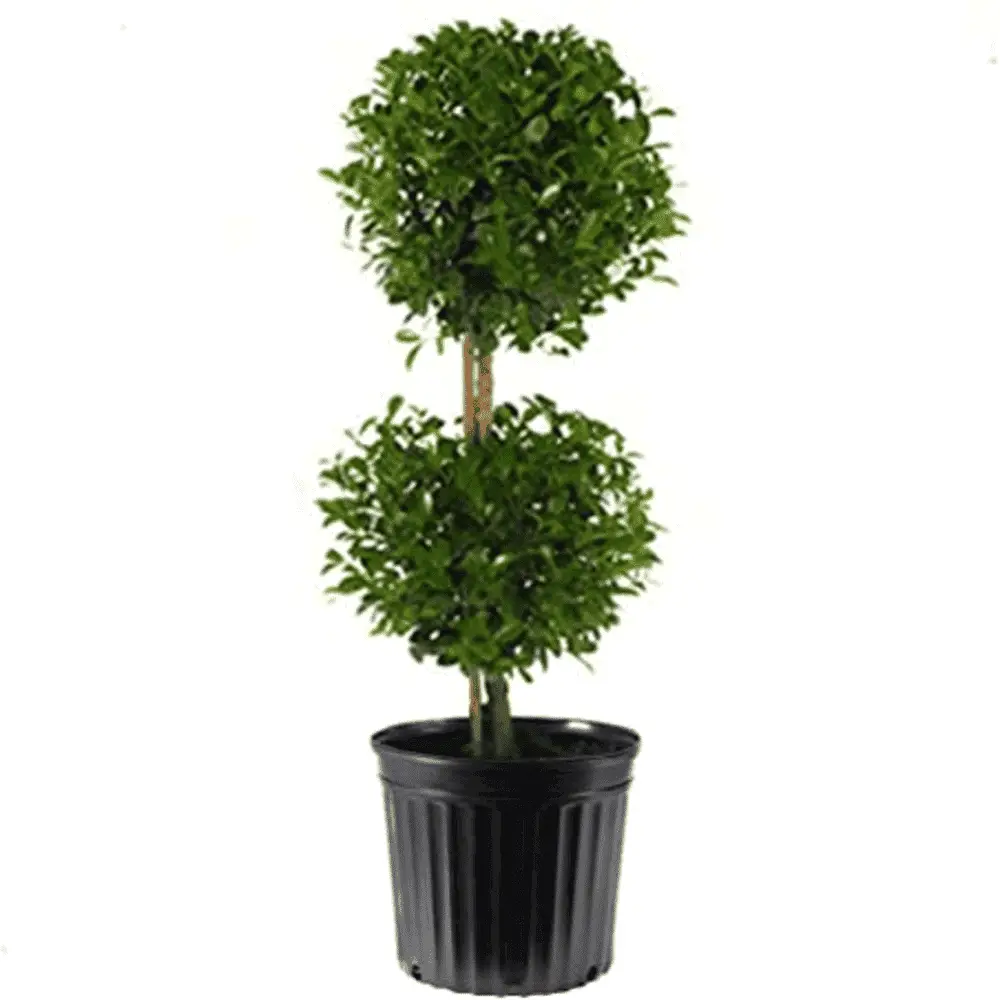Looking for a unique way to spruce up your garden or home? Why not try growing a eugenia topiary? These evergreen plants make perfect additions to any home or garden, and with the proper care and growing guide, they’re easy to grow too!
Keep reading for more information on how to care for your eugenia topiary and tips on getting it to grow big and healthy.
What is an Eugenia Topiary plant?
The eugénie topiary is a beautiful plant that can be grown both indoors and outdoors. It has wide cultivated for its leaves, making it an interesting landscape or indoor decoration depending on your preference.
One of the most popular shapes involving this variety includes training one ball connected to two others by stems at their center which gives them balls shape in order display proudly outside while still being able grow well inside if needed!
Eugenia Topiary Care & Growing Guide
1. Light Requirement
These plants tend to thrive when given at least four hours of full to partial natural sunlight in the morning and late afternoon. You should avoid exposing them to direct sunlight in the mid-afternoon hours. Too much direct light when the sun is at its brightest can actually scorch the leaves.
2. Water
The soil that the Eugenia topiary is in must be kept fairly moist at all times. It is important that you use distilled water in the spring and summer months. You only have to water this plant 2-3 times each week in the colder months of the year.
You should put the potted plant into a bucket or deep bowl filled with water. This will ensure that the plant’s soil stays moist on a consistent basis.
Once you have done that, you’ll only need to water the plant when the soil gets dry half an inch down. You can put your finger into the soil if you aren’t sure whether or not to water it yet.
3. Climate
This plant can grow in a variety of regions, including tropical areas. It is, however, important to provide it with shade when the sun is at its brightest in the afternoon. You can grow them in agriculture plant hardiness zones 9 through 11.
4. Soil
If you are going to grow your Eugenia inside, you will need to use a potting soil that drains well. It is also important that you choose a big pot with numerous holes to allow for drainage. You should put in a good amount of sand as well for maximum porosity.
It is a good idea to keep these plants in acidic soil. If you are planting outside, you’ll have to till to a depth of 18 inches minimum. Make sure that you take out any big rocks when preparing your plant’s new home.
5. Temperature
If you plan on growing these plants outside, you’ll want to cover them up if the temperature goes below 32 degrees Fahrenheit. These plants handle cold weather fairly well, but they do have their limits.

6. Repotting
You should only have to repot this plan every three years once spring rolls around. Make sure that you use a good amount of fertilizer to encourage healthy growth.
7. Speed of Growth
Eugenia plants grow at an average speed of four feet per year. You can encourage growth with a slow-release fertilizer.
8. Height and Spread
The Eugenia topiary can grow up to 48 inches tall with a maximum width of 20 inches. While it is not a huge plant, you still need to pick a spot outside where it won’t get crowded. It is a good idea to leave a space of at least 12 inches from other plants.
Similar post: Song of India: Plant Care
9. Flowers
This plant produces green foliage and white flowers along with bright red fruit, which is commonly known as Surinam cherries.
Learn more: Spider Lily: Plant Care & Growing Guide
10. Trimming
While this plant grows pretty slowly, you will need to trim it quite often to keep a nice shape. It is highly recommended that you use gardening shears that are very sharp; this will make pruning this plant a lot easier.
As your plant grows, you’ll need to remove the new growth every three weeks or so. Make sure that you wipe off the shears between uses to keep them clean.
How to get Eugenia Topiary Plants to Flower
The most effective method for getting Eugenia topiaries to flower is to provide them with ideal soil that drains well and is on the acidic side. You also need to make sure that it doesn’t get any direct sunlight in the early to mid-afternoon hours.
These plants only flower in warm climates, and they can do so up to four times each year. Those who try to grow their Eugenia in a colder region will likely have problems getting it to flower. If this is the case, you might have to grow yours inside.
Also read: Dischidia: Plant Care & Growing Guide
Common Eugenia Topiary Diseases
Eugenia topiaries are prone to fungal diseases, which present as rusty spots on the leaves. Make sure that you carefully remove all of the affected leaves to stop the spread of the infection. You should also keep the foliage as dry as possible.
Certain scale insects like armored scales can become a big problem for Eugenia plants as well. It is a good idea to spray your plants with oil on a regular basis to avoid this problem. If you are having a problem with these pests, you will notice the leaves on the plant turning yellow and dropping before they should.
If you are having a problem with slugs or snails on your plant, you’ll want to remove everything that these pests can slide along. This includes weeds around tree trunks, stones, or any other surfaces that allow them to get onto your plants.
Keep reading:
- Pothos Plant Care & Growing Guide
- Moses in the Cradle Plant Care & Growing Guide
- Thryallis Plant Care & Growing Guide
- Parlor Palm (Chamaedorea Elegans) Care & Growing Guide
Conclusion
- It is a good idea to provide your Eugenia topiary with partial to full sunlight in the morning and early afternoon hours.
- Avoid exposing these plants to bright mid-afternoon sunlight without any shade, as this will scorch the leaves.
- During the colder months of the year, you’ll only have to water these plants two to three times every week.
- During the warmer months, make sure that you keep the soil the plant is in nice and moist with distilled water.
- If you are growing these plants outdoors, you’ll want to take them inside if you expect the temperature to drop below 32 degrees Fahrenheit.
- These plants tend to grow fairly slow, about 4 feet per year.
- The white flowers that this plant produces are very small but beautiful nonetheless.
- You will have to trim this plant fairly often in order to maintain an ideal shape.
Victoria is the owner and main author of hobby plants. She loves spending her free time in her garden planting and taking care of her plants. Victoria hopes you enjoy the content here!
![Mother Of Thousands Plant [Complete Plant Care Guide] Mother Of Thousands Plant [Complete Plant Care Guide]](https://www.hobbyplants.com/wp-content/uploads/2022/07/mother-of-thousands-plant-300x158.jpg)




![Majesty Palm Plant Care: [Complete Beginner's Guide] Majesty Palm Plant Care: [Complete Beginner's Guide]](https://www.hobbyplants.com/wp-content/uploads/2022/08/majesty-palm-care-300x158.jpg)
![Exotic Angel Plant Care: [Complete Beginner's Guide] Exotic Angel Plant Care: [Complete Beginner's Guide]](https://www.hobbyplants.com/wp-content/uploads/2022/08/exotic-angel-plant-care-300x158.jpg)
![Snow White Waffle Plant: [Complete Care Guide] Snow White Waffle Plant: [Complete Care Guide]](https://www.hobbyplants.com/wp-content/uploads/2022/08/snow-white-waffle-plant-300x158.jpg)
![Waffle Plant Care: [Complete Beginner's Guide] Waffle Plant Care: [Complete Beginner's Guide]](https://www.hobbyplants.com/wp-content/uploads/2022/08/waffle-plant-300x158.jpg)
![Bird Of Paradise Plant Care: [Complete Beginner's Guide] Bird Of Paradise Plant Care: [Complete Beginner's Guide]](https://www.hobbyplants.com/wp-content/uploads/2022/08/bird-of-paradise-plant-300x158.jpg)
![Purple Passion Plant Care: [Complete Beginner's Guide] Purple Passion Plant Care: [Complete Beginner's Guide]](https://www.hobbyplants.com/wp-content/uploads/2022/08/purple-passion-plant-care-300x158.jpg)
![China Doll Plant Care: [Complete Beginner's Guide] China Doll Plant Care: [Complete Beginner's Guide]](https://www.hobbyplants.com/wp-content/uploads/2022/09/china-doll-plant-care-300x158.jpg)
